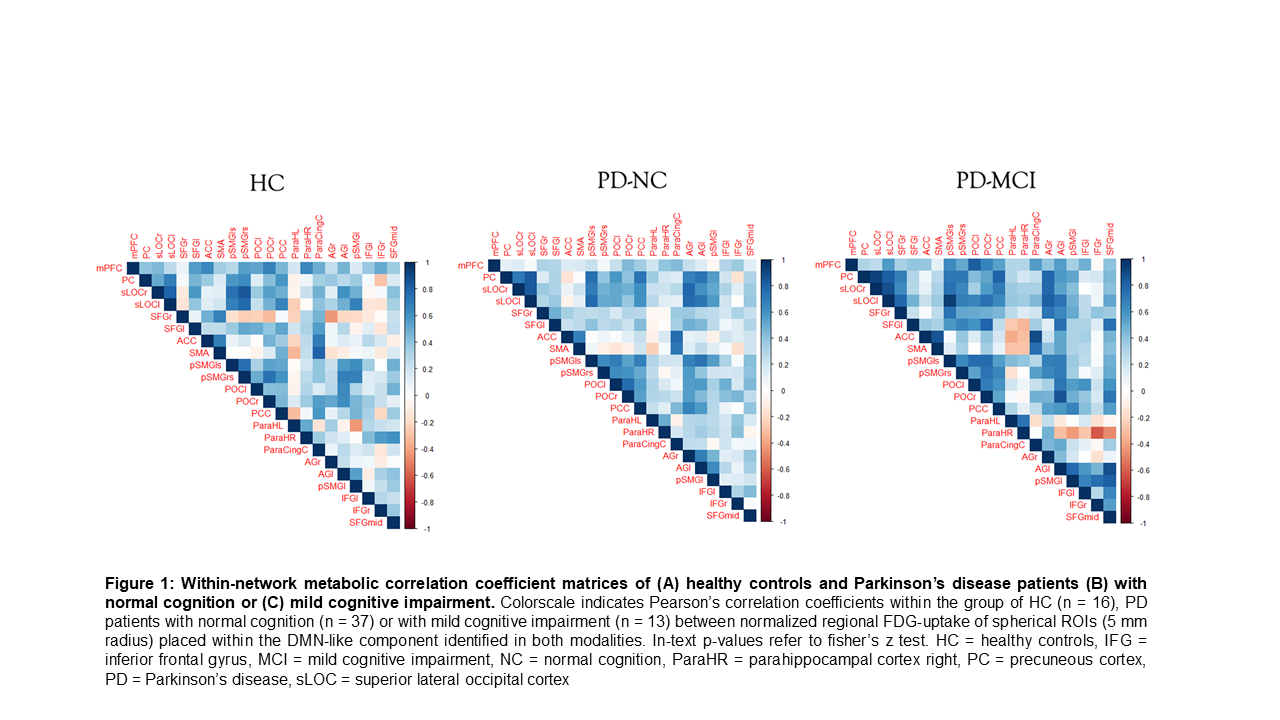Category: Parkinson's Disease: Neuroimaging
Objective: To assess the correspondence between functional connectivity and metabolic covariance in healthy controls and Parkinson’s disease patients (PD) with and without cognitive impairment.
Background: Although glucose serves as the main neural source of energy, the relation between interregional correlated hemodynamic fluctuations (functional connectivity) obtained by fMRI and coherent metabolic activity assessed by FDG-PET remains largely unresolved [1]. Limited evidence suggests an association between both functional measures [2,3]. Several studies emphasize that metabolic measures, reflecting likewise regional metabolism or cross-modal metrics, might represent promising markers of cognitive dysfunction in neurodegenerative diseases [4,5,6,7].
Method: Functional and metabolic covariance patterns were identified in FDG-PET and fMRI data of 16 PD patients and 16 healthy controls using independent component analysis (ICA, GIFT). PET scans were intensity-normalized using Yakushev normalization [8]. ICA was performed on concatenated PET images and subjects’ fMRI data. Interregional correlations between hemodynamic fluctuations or metabolic activity were assessed by using spherical ROIs placed within components resembling the default-mode network (DMN) and compared (t– or fisher’s z test) between healthy controls and patients with and without mild cognitive impairment (MCI).
Results: In both modalities, an increased correlation between the precuneous cortex (PC) and the bilateral lateral occipital cortex (LOC) was observed in patients compared to healthy controls. Interregional correlation analysis revealed increased correlation in metabolic activity between the PC and LOC in patients compared to healthy subjects [figure 1], which was more pronounced in PD patients with MCI (p<0.05). PD-MCI patients showed decreased correlation between the right parahippocampal gyrus and the inferior frontal cortex compared to PD-NC patients (p<0.01).
Conclusion: The overlapping characteristics of identified DMN components in both modalities suggest a common spatial distribution of intrinsic functional connectivity and coherent metabolic activity across subjects. Interregional correlation analysis revealed that fMRI dysconnectivity partly is accompanied by similar changes in metabolic activity in cognitively unimpaired patients that progress in PD with MCI.
References: (1) Wehrl, Hans F.; Hossain, Mosaddek; Lankes, Konrad; Liu, Chih-Chieh; Bezrukov, Ilja; Martirosian, Petros et al. (2013): Simultaneous PET-MRI reveals brain function in activated and resting state on metabolic, hemodynamic and multiple temporal scales. In: Nature medicine 19 (9), S. 1184–1189. DOI: 10.1038/nm.3290. (2) Passow, Susanne; Specht, Karsten; Adamsen, Tom Christian; Biermann, Martin; Brekke, Njål; Craven, Alexander Richard et al. (2015): Default-mode network functional connectivity is closely related to metabolic activity. In: Human brain mapping 36 (6), S. 2027–2038. DOI: 10.1002/hbm.22753. (3) Riedl, Valentin; Bienkowska, Katarzyna; Strobel, Carola; Tahmasian, Masoud; Grimmer, Timo; Förster, Stefan et al. (2014): Local activity determines functional connectivity in the resting human brain: a simultaneous FDG-PET/fMRI study. In: The Journal of neuroscience : the official journal of the Society for Neuroscience 34 (18), S. 6260–6266. DOI: 10.1523/JNEUROSCI.0492-14.2014. (4) Toussaint, Paule-Joanne; Perlbarg, Vincent; Bellec, Pierre; Desarnaud, Serge; Lacomblez, Lucette; Doyon, Julien et al. (2012): Resting state FDG-PET functional connectivity as an early biomarker of Alzheimer’s disease using conjoint univariate and independent component analyses. In: NeuroImage 63 (2), S. 936–946. DOI: 10.1016/j.neuroimage.2012.03.091. (5) Spetsieris, Phoebe G.; Ko, Ji Hyun; Tang, Chris C.; Nazem, Amir; Sako, Wataru; Peng, Shichun et al. (2015): Metabolic resting-state brain networks in health and disease. In: Proceedings of the National Academy of Sciences of the United States of America 112 (8), S. 2563–2568. DOI: 10.1073/pnas.1411011112. (6) Sala, Arianna; Caminiti, Silvia Paola; Presotto, Luca; Premi, Enrico; Pilotto, Andrea; Turrone, Rosanna et al. (2017): Altered brain metabolic connectivity at multiscale level in early Parkinson’s disease. In: Scientific reports 7 (1), S. 4256. DOI: 10.1038/s41598-017-04102-z. (7) Scherr, Martin; Utz, Lukas; Tahmasian, Masoud; Pasquini, Lorenzo; Grothe, Michel J.; Rauschecker, Josef P. et al. (2019): Effective connectivity in the default mode network is distinctively disrupted in Alzheimer’s disease-A simultaneous resting-state FDG-PET/fMRI study. In: Human brain mapping. DOI: 10.1002/hbm.24517. (8) Yakushev, Igor; Hammers, Alexander; Fellgiebel, Andreas; Schmidtmann, Irene; Scheurich, Armin; Buchholz, Hans-Georg et al. (2009): SPM-based count normalization provides excellent discrimination of mild Alzheimer’s disease and amnestic mild cognitive impairment from healthy aging. In: NeuroImage 44 (1), S. 43–50. DOI: 10.1016/j.neuroimage.2008.07.015.
To cite this abstract in AMA style:
M. Ruppert, A. Greuel, M. Tahmasian, K. Steidel, F. Maier, J. Hammes, T. van Eimeren, L. Timmermann, M. Tittgemeyer, A. Drzezga, C. Eggers. Altered metabolic and functional resting state activity in cognitively unimpaired and impaired Parkinson’s disease patients [abstract]. Mov Disord. 2020; 35 (suppl 1). https://www.mdsabstracts.org/abstract/altered-metabolic-and-functional-resting-state-activity-in-cognitively-unimpaired-and-impaired-parkinsons-disease-patients/. Accessed April 26, 2025.« Back to MDS Virtual Congress 2020
MDS Abstracts - https://www.mdsabstracts.org/abstract/altered-metabolic-and-functional-resting-state-activity-in-cognitively-unimpaired-and-impaired-parkinsons-disease-patients/

